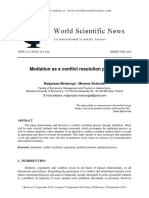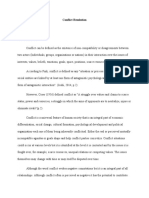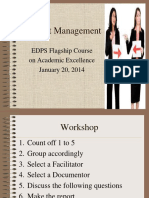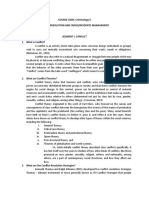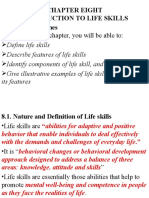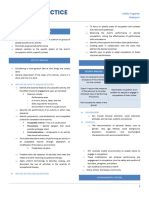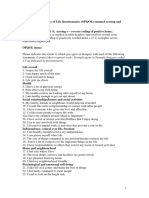MODULE: TOWARDS ANALYSING THE DYNAMICS, ROLE AND RESOLUTION OF
CONFLICT IN AFRICAN SOCIETIES
FACILITATOR: GADDAFI MU’AZU
Background
The phenomenon of conflict in human society is found at every stage of life. This is because
individuals, groups, societies, local, national and even the world community continue to
experience conflicts in one way or the other. Therefore, conflict is a permanent feature of life
that societies have come to live and cope with, and resolve from time to time. The pillar of
worry in conflict is in its violent form, because when conflicts are not violent, that is, when
they are constructive and are made to challenge existing grounds, they become a good source
of social change. But when conflicts become violent, resulting to loss of lives, property, trust
and their likes, it then becomes an undesirable element that challenges peaceful coexistence,
order and development.
Due to the complex nature of conflict, it is pertinent then to evolve effective ways of handling
the phenomenon. To deal with a conflict effectively, it first needs to be analysed and
understood. This chapter seeks to provide a framework towards understanding conflict and its
dynamics, as well strategies for effective resolution.
Understanding Conflict
According to Coser (1956) Conflict is a struggle between opponents over values and claims
to scarce status, power and resources. This struggle can be intrapersonal, interpersonal,
intergroup, intrasociety or international global. And because it is mostly violence redden, its
resolution is sorted. Violence can be categorized as either small or large-scale depending on
the intensity. Large scale violence is difficult to control and its consequences are hard to
predict (Coady, 1999).
Conflict Analysis
In analysing conflict, getting information and evidence that is directly and indirectly related
to a conflict is of paramount importance. This is in addition to interpreting and evaluating the
information collected. Conflict analysis enables the identification of the type of the conflict;
the reasons for the conflict; the causes and consequences of the conflict; the components and
the different actors involved; and the levels at which the conflict takes place. Conflict
1
�analysis also provides information on how the conflict is seen (for example, manifest, latent),
its dynamics, the relationships and hierarchy of positions between the conflicting parties, and
their interests, needs and motivations.
Conflict Analysis Methods
Conflict Mapping
ABC Triangle
Onion of Position, Interest and Needs
Tree of Conflict
Pyramid of Conflict
Dynamics of Conflict
Here, we look at how all the different elements of conflict interact, develop and change in
their lifetime. Like many social phenomenon, conflict do not happen haphazardly, there is
always a source of conflict, followed by stages which then gradually conflagrate to full blown
conflict. It is not always easy to establish the sequence of events that leads to the emergence
of a conflict. But attempts have been made to understand the different changes that exist in
the conflict process, as well the changes that occur from stage to stage. In effect, four (4)
stages can be identified in the transformation stage:
Pre-conflict Stage: This is characterized by conditions favourable to conflict,
incompatibility of goals exist among the parties where each is nursing different
expectations, goals, rights e.t.c.
Confrontation Stage: Characterized by tension, in which the conflict begins to brew,
demands been made, agitations and at some points polarized on their stands. This
stage features low levels of violence such as minor scuffles and incidences among
parties.
Crises Stage: This is marked by violent confrontations and full blown conflicts,
where conflicts intensifies, with causalities mostly from parties involved in the
conflict, large scale population displacements, destructions of lives and property e.t.c.
Though at the climax of conflict in this stage, parties tend to count on their losses and
have a rethink on continuing with the conflict.
Post-conflict Period: At this stage, with the secession of hostilities, the processes of
addressing the underlying causes of the conflict are put in place. In particular, the
2
� needs, fears, aspirations and grudges of the parties are looked into, and attempts are
made to resolve conflict.
The stages outlined above are not necessarily mutually exclusive categories in reality. Certain
overlaps tend to occur between or among them. As a matter of fact, the distinction drawn is
more analytical and academic than factual.
Conflict Resolution
Since conflict is permanent, and people suffer its violence consequences, there is need for
developing effective resolution mechanisms. Conflict resolution is a process by which
communication is used to assemble parties to conflict with a view to reducing differences and
resolving conflicts. This will enable the parties arrive at amicable and satisfactory consensual
ideas and views. Conflict resolution implores variety of approaches aimed at terminating
conflict through constructive solving of problems. It is also conceived as an outcome in
which the issues in an existing conflict are satisfactorily dealt with through a solution that is
mutually acceptable to the parties. The solution should also be self-sustaining in the long-run
and productive of a new, positive relationship between parties that were previously hostile
adversaries. From a broader perspective, there are two (2) methods conflict can be resolved.
This includes Regular Dispute Resolution (RDR) and Alternative Dispute Resolution (ADR).
a. Regular Dispute Resolution (RDR)
The regular dispute resolution includes the regular system of administrative, judicial or
legislative decision making processes of conflict resolution. This also includes litigation in
court, that is, through legal process. Under this system, the winner takes it all. There is
always a winner/loser ending, (Peters, 2006). This particular form of conflict resolution
method is not much in practice as it tends to delay resolution or sometime becoming
ineffective.
b. Alternative Dispute Resolution (ADR)
As it name implies, this includes the methods that are alternative to the regular system. In this
type of dispute resolution strategy, people are encouraged to go for a win-win solution
(instead of a win-lose or lose-lose situation). ADR is associated with a variety of specific
conflict resolution options such as mediation, conciliation, arbitration, dialogue amongst
3
�others, (Tjosvold and Van de Viliert, 1994). It is a process through which disputes are
resolved privately by the parties other than resorting to litigation in the traditional courts. It is
a system of multi-option justice in which a wide range of dispute resolution processes are
available to parties involved in a conflict. ADR has the advantage of time and other resources
because it does not allow long period before conflict or dispute is resolved as in the case of
court resolution, as well making resolving conflict society rooted.
Alternative Dispute Resolution (ADR) involves the institutionalization of certain procedures,
structures and apparatus in resolving conflict. The major components of such management of
conflicts include: prevention of any imagined, presumed or real ongoing conflicts and
resolution of brewing and existing conflictual happenings or events between and among
individuals, groups and communities. Principal among these strategies of conflict resolution
include:
i. Mediation
This involve enactment of statutory mechanisms to make it obligatory for disagreeing parties
to meet within certain time frame under the guidance and leadership of a mediator mutually
agreed upon and appointed by one or both of the parties with a view to amicably settling their
dispute(s). In mediation, the parties appoint a neutral person who will guide them in their
resolution of the conflict. The mediator does not adjudicate or give judgment. Mediation is
guided by negotiation. The mediator is not a party to the negotiation but a contributory
observer.
ii. Conciliation
Under this procedure, a conciliator is appointed for the parties for the purpose of affecting a
resolution of conflict. The conciliator is to investigate the causes and circumstances of the
disagreement and nature of the disputants to enable negotiation with the parties to effect
settlement if necessary. In conciliation, background information has to be gathered by the
conciliator in order to guide the resolution of conflicts. The conciliator needs some powers
from a recognized authority, to be able to persuade and exact resolution of conflict.
4
� iii. Arbitration
It is another means by which government lays down the rules on how conflicts could be
resolved among conflicting parties as a step further from conciliation. It marks the beginning
of judicial process for conflict resolution. This is in reference to disputes or differences
between parties, where hearing from both sides is arranged in a judicial manner, by a person
or persons other than a court of competent jurisdiction otherwise called an arbitrator. The
arbitrator is described as an arbiter between feuding parties and any decision reached by the
arbiter becomes binding or non-binding.
Here, the third party is invested with so much confidence and trust that its decisions are
binding on the parties involved. It is one of the conflict escalation avoidance options. The
arbiter poses and acts as a judge, listening impartially to the two parties. What makes
arbitration effective is the voluntary selection of the arbiter by the disputing parties as well as
an express consent that its decisions will be accepted as binding. The authoritative decision is
called award, (Best, 2006).
iv. Dialogue
In dialogue, the parties meet without a third party and work at resolving their conflict. This is
a very popular form of dispute resolution in most traditional societies in Africa, as parties to a
conflict come together to discuss and settle their differences. Most of the times, parties to
conflict by themselves see the need to resolve conflicts between themselves after
experiencing the cost of conflict. This strategy has the following four ‘4’ components:
- Separate the people from the problem
- Focus on interests not positions
- Generate a variety of possibilities before deciding on what to do
- Insist on some objective standards
Dialogue is designed to de-emphasize the rigidity held in interests, sentiments, and fears. It
builds mutual confidence in the ability and capacity of the disputing parties in coming
together, talking together, and resolving issues together in a frank and friendly environment.
The setting of negotiation is preferably a neutral ground, and the parties must shun rigidity or
insistence on a particular way out of the issues. Dialogue is thus a process, which involves a
5
�good listening attention against provocative emotions or utterances. Hence it is both
cooperative and collaborative in both nature and process. (Best, 2009).
Conclusion
In all, conflict have been found to be inevitable in all human societies, and have come to be a
phenomenon we must cope with in our daily lives. Not all conflicts are negative, but violent
conflicts have resulted in monumental loss of lives, properties, distrust, and ultimately
breakdown of peaceful coexistence, necessary for development. Thus, understanding conflict,
its dynamics and resolution have become necessary in ensuring that conflicts are effectively
resolved, making societies stable and progressive.














